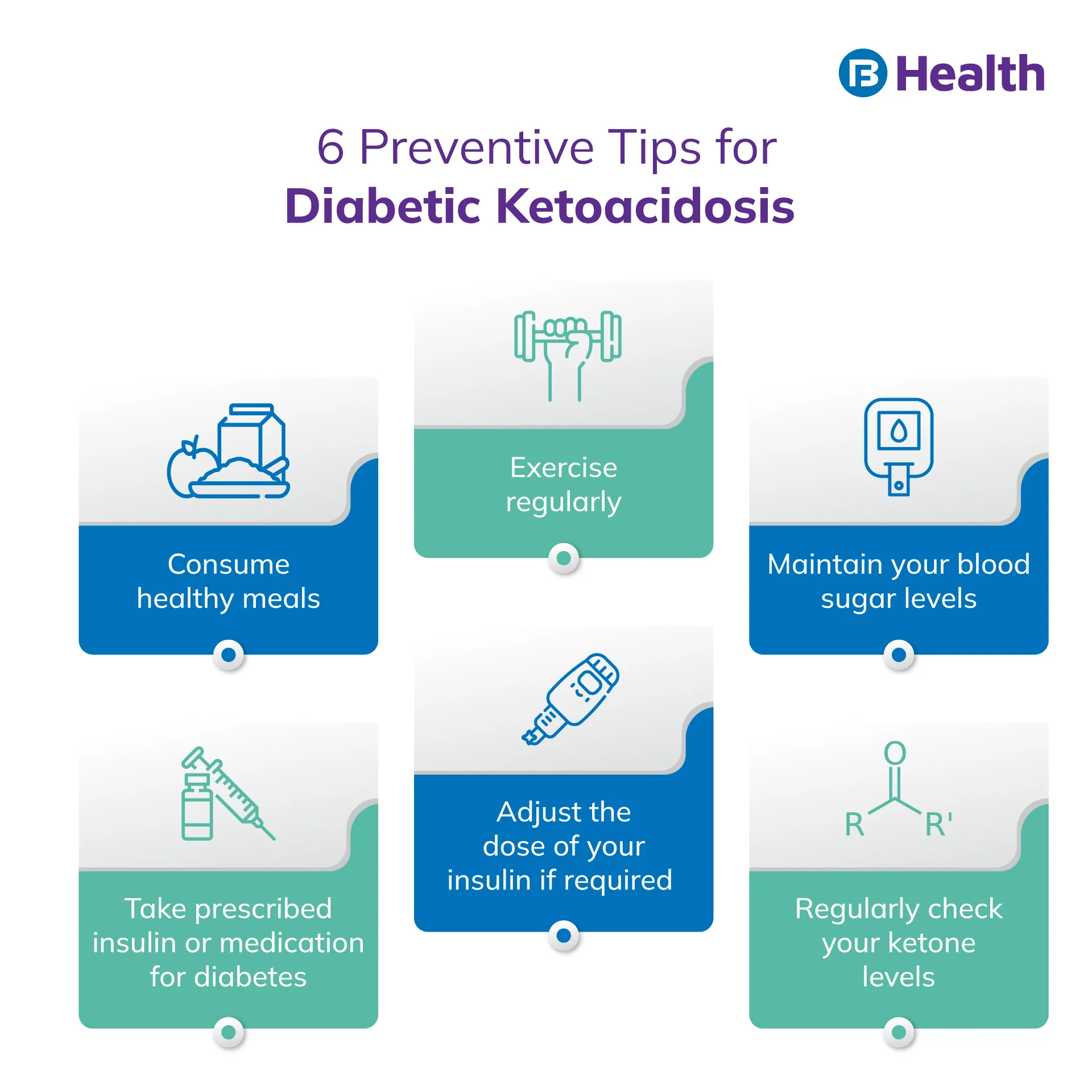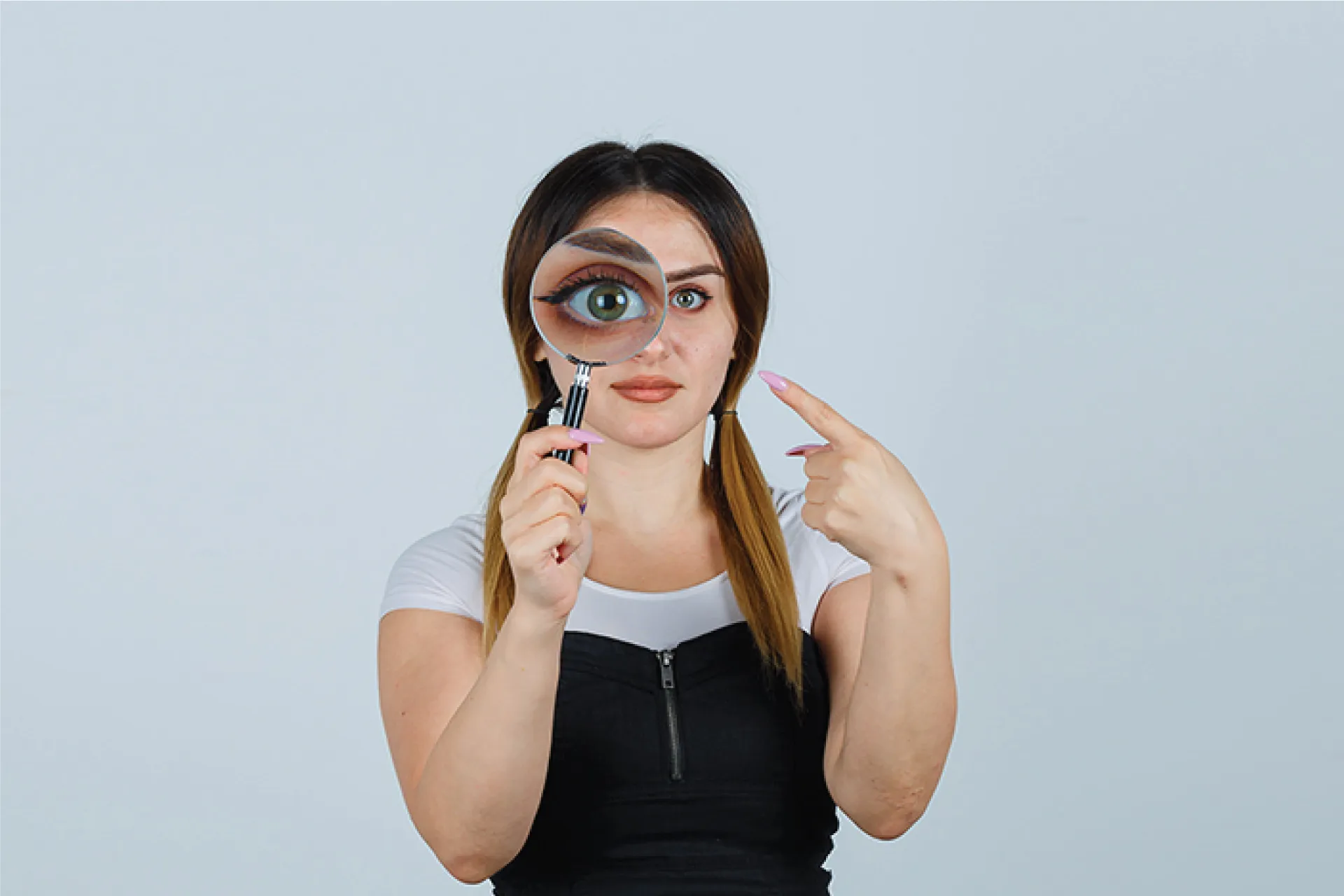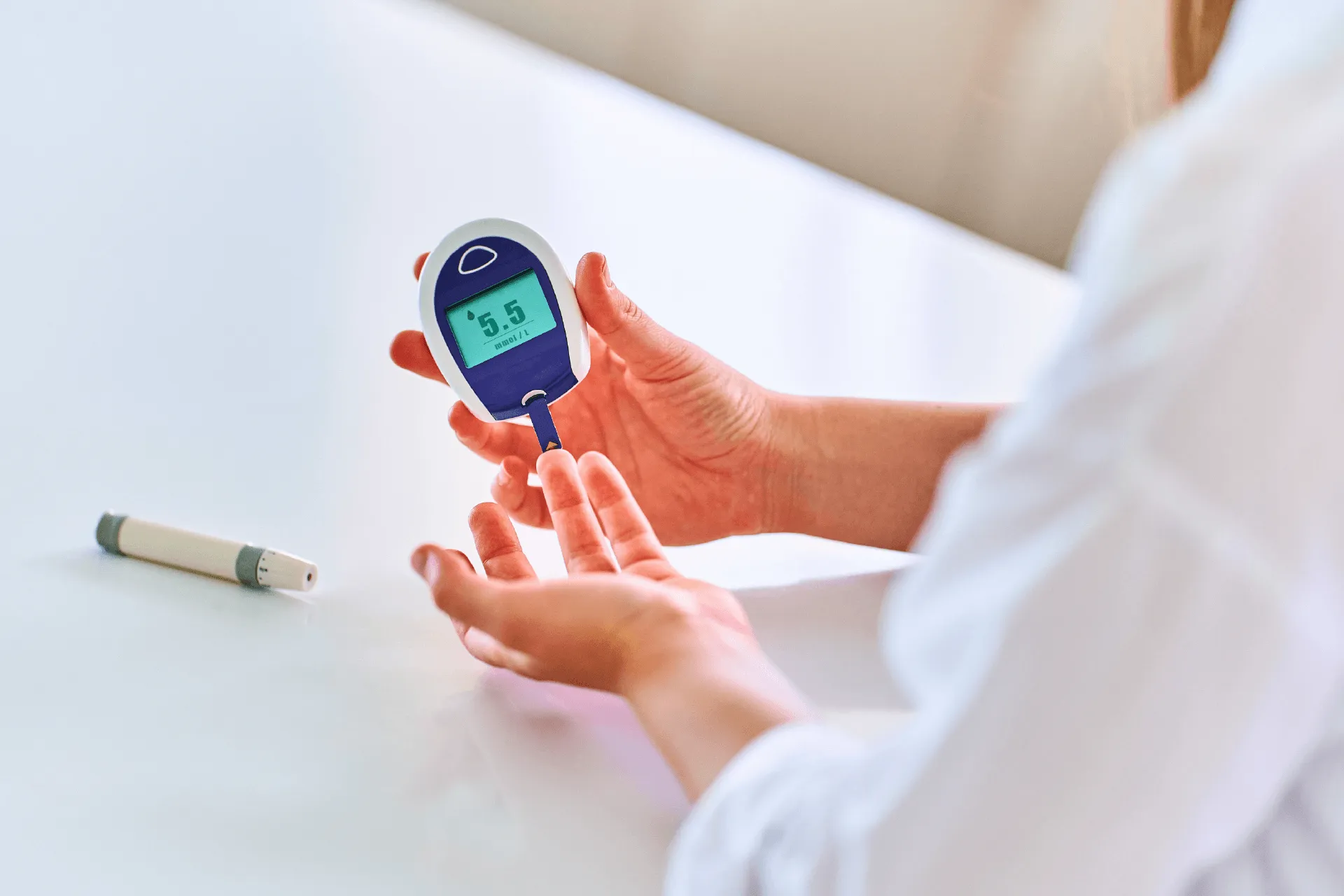Diabetes | 5 min read
Diabetic Ketoacidosis: Causes, Symptoms, Treatment and more
Medically reviewed by
Table of Content
Key Takeaways
- When you have high sugar levels for long, it can lead to diabetic ketoacidosis
- Diabetic ketoacidosis is less common in people who have type 2 diabetes
- Diabetic ketoacidosis symptoms include fatigue, nausea, and vomiting
Diabetic ketoacidosis definition refers to a buildup of acids in your blood. The acidic buildup happens when your blood sugar levels are high for a long period. Also known as DKA, this complication is accompanied by a high quantity of blood acids known as ketones. When your body breaks down the fat at a very rapid pace, the liver processes that fat into ketones. This can cause your blood to become acidic and lead to complications like DKA.
Diabetic ketoacidosis should not be confused with ketosis which is not as severe. Ketosis is a result of a ketogenic diet, which is a very low carbohydrate diet or from fasting. DKA happens when your body does not have enough insulin to process blood sugar into energy. It is more common in people with type 1 diabetes and less common in cases of type 2 diabetes.
Read on to know more about diabetic ketoacidosis causes, symptoms, treatment, and more.
What are the causes of diabetic ketoacidosis?
DKA is mainly caused by insufficient levels on insulin in your body. Diabetic ketoacidosis causes for low insulin levels are:
Type 1 diabetes
Also known as insulin dependent diabetes, this an autoimmune and chronic condition. Your immune system attacks the beta cells in your pancreas that help produce insulin. In some cases when people have a delayed diagnosis, they may have DKA. In this condition, their body cannot use glucose for energy due to insufficient insulin levels. If you want to protect yourself from type 1 diabetes you can avail diabetes health insurance.
Additional Read: Signs & Symptoms of DiabetesTips for diabetic ketoacidosis prevention

Missed or insufficient insulin dose
In case you have type 1 diabetes, your body will need injected insulin to function properly. If you miss one or more than one insulin doses, it can lead to low levels of sugar. This in turn can cause diabetic ketoacidosis. Other than this, it can also be insufficient if your insulin pump or tubing malfunctions.
Expired or spoiled insulin intake
Insulins are usually affected by extreme weathers that make them ineffective. Apart from this, taking an expired dose is also ineffective to maintain your insulin levels. Make sure you read the storage instructions and expiry to avoid such situations.
Other than the above, the following conditions can cause diabetic ketoacidosis:
- Illnesses that can cause high production of hormones like cortisol
- Infections that make it harder for your body to use insulin
- Pregnancy in diabetic people which can cause insulin resistance
- Physical or emotional trauma
- Pancreatitis or heart attack
- Alcohol or drug abuse
- Intake of certain medications
Common diabetic ketoacidosis symptoms
Knowing diabetic ketoacidosis symptoms can help you get timely diagnosis and treatment. Make sure you remember the following signs if you are at risk or already have type 1 diabetes:
- Frequent urination
- Dehydration
- Extreme thirst
- Headache
- High ketone levels detected in an at-home test
- Blood sugar levels over 250 mg/dL
Some severe signs of DKA are:
- Vomit and nausea
- Shortness of breath
- Breath that smells like fruit
- Abdominal pain
- Decreased alertness
- Fatigue or weakness
- Confusion or disorientation

How is diabetic ketoacidosis diagnosed?
DKA is generally diagnosed when you have the following conditions:
- Your blood sugar levels are high
- Your Blood pH is below 7.3, which indicates acidosis
- Your blood or urine contains ketones
- Your serum bicarbonate level is below 18mEq/L
If doctors suspect diabetic ketoacidosis, they may order the following tests [1]:
- Blood glucose test
- Basic metabolic panel
- Osmolality blood test
- Ketone tests
- Arterial blood gas
- Beta hydroxybutyrate test
- Complete blood count test
What are diabetic ketoacidosis treatment options?
Your diabetic ketoacidosis treatment will usually include a combination of methods. The focus of the treatment will be to bring your blood sugar levels and insulin to a normal range. If you are not diagnosed with diabetes, your doctor may form a treatment plan to avoid recurrence. If you have DKA caused by an infection, your doctor may treat the infection with antibiotics.
Apart from these, your diabetic ketoacidosis treatment plan may include the following:
Electrolyte replacement
Electrolytes are minerals found in your blood, which carry electric charges like chloride, sodium, or potassium. Low insulin levels can decrease the levels of electrolytes present in your blood. This is why injecting electrolytes through a vein may help to keep your vital body functions normal
Fluid replacement
In diabetic ketoacidosis, loss of fluid can lead to a reduced amount of blood flow in your body. Under such situations, fluid replacement can help restore your blood flow to normal. Other than this, fluid replacement can also help treat dehydration, which can otherwise cause your blood sugar levels to rise and put you at risk of DKA.
Insulin therapy
Insulin therapy helps reverse the process that caused DKA. Along with the previous two processes, you may receive insulin therapy to bring your sugar levels within normal range. It is generally given through a vein and is administered until your blood sugar levels fall down to 200 mg/dL [2]. Blood sugar levels around or below 200 mg/dL indicate that your blood is no longer acidic.
Additional Read: Type 1 and Type 2 DiabetesDiabetic ketoacidosis complications
Possible diabetic ketoacidosis complications include the following health conditions [3]:
- Kidney failure
- Cerebral edema (build-up of fluid in your brain)
- Cardiac arrest (your heart stops working)
In cases of diabetic ketoacidosis, it is important to get timely treatment. This is why you should be aware of its symptoms. If you notice any signs of diabetic ketoacidosis, contact a doctor immediately. To get doctor consultation, book an appointment on Bajaj Finserv Health. Avail Bajaj Finserv Health card and get 10 free online consultations with top specialists. You can book an online or in-clinic doctor consultation appointment with top specialists. This way, you can get treatment even in remote space without any delay. Choose from the affordable full-body checkup packages available on the platform. This will help you track your health without impacting your pocket!
References
- https://www.ncbi.nlm.nih.gov/books/NBK279146/
- https://www.mayoclinic.org/diseases-conditions/diabetic-ketoacidosis/diagnosis-treatment/drc-20371555
- https://medlineplus.gov/ency/article/000320.htm
Disclaimer
Please note that this article is solely meant for informational purposes and Bajaj Finserv Health Limited (“BFHL”) does not shoulder any responsibility of the views/advice/information expressed/given by the writer/reviewer/originator. This article should not be considered as a substitute for any medical advice, diagnosis or treatment. Always consult with your trusted physician/qualified healthcare professional to evaluate your medical condition. The above article has been reviewed by a qualified doctor and BFHL is not responsible for any damages for any information or services provided by any third party.





